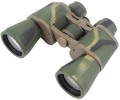Real angle of view
The section of the panorama that can be viewed through the eyepieces of binoculars. The higher the actual angular field of view, the wider the visibility of the optics. Note that the angular field of view has an inverse relationship with magnification. That is, the higher the magnification, the narrower the visibility (the smaller the real angular field of view). The actual angular field of view is calculated as follows: you need to divide the angular field of view (in degrees °) by the magnification factor. In comparison, the human eye has an angular field of view of 60 arcseconds (“). In terms of degrees, you get 150 °. Good binoculars provide a real field of view somewhere within 10 arcseconds. But it does not always make sense to chase after large indicators of the real angular field of view. The fact is that when viewing a large section of the panorama, the edges of the image receive noticeable distortion.
Min. focus distance
The smallest distance to the observed object, at which it will be clearly visible through binoculars / monoculars. All such optical instruments were initially created for observing remote objects, therefore, not all of them are able to work at short distances. When choosing a model for this parameter, one should proceed from the expected observation conditions: ideally, the minimum focus distance should not be greater than the smallest possible distance to the observed object.
Relative brightness
One of the parameters describing the quality of visibility through an optical device in low light conditions. Relative brightness is denoted as the diameter of the exit pupil (see below) squared; the higher this number, the more light the binoculars/monoculars let through. At the same time, this indicator does not take into account the quality of lenses, prisms and coatings used in the design. Therefore, comparing the two models in terms of relative brightness is only possible approximately, since even if the values are equal, the actual image quality may differ markedly.
Diopter correction range
The range of values in which diopter adjustment can be made (see above). If you wear glasses with diopters, but plan to look through binoculars / monoculars without them, you should choose a model whose range would correspond to the characteristics of the glasses (or at least be as close as possible to them).
Eye relief
The offset is the distance between the eyepiece lens and the exit pupil of an optical instrument (see "Exit Pupil Diameter"). Optimum image quality is achieved when the exit pupil is projected directly into the observer's eye; so from a practical point of view, offset is the distance from the eye to the eyepiece lens that provides the best visibility and does not darken the edges (vignetting). A large offset is especially important if the binoculars / monoculars are planned to be used simultaneously with glasses — because in such cases it is not possible to bring the eyepiece close to the eye.
Prism material
Material used for prisms found in binoculars and monoculars.
-
BK-7. A type of borosilicate optical glass (6LR61), a relatively inexpensive and at the same time quite functional material that provides, although not outstanding, quite acceptable image quality. Used in entry-level and mid-level models.
—BaK-4. Barium optical glass, noticeably superior to BK7 in brightness and image clarity, is however also more expensive. Accordingly, it is found mainly in the premium segment.
Dustproof, water resistant
The body of the binocular / monocular
is protected from dust and moisture. You should pay attention to such models if you plan to use the device in nature — while hiking, hunting, fishing, etc. The degree of such protection can vary, from splash resistance to water immersion; this point should be clarified according to the official characteristics. Also note here that most of the "waterfowl" models usually have gas filling (see above), and the absence of such filling, usually, indicates low moisture resistance.
Tripod adapter
The presence in the design of the binoculars / monocular
socket for attaching an adapter for a tripod(the adapter itself is not included in the kit, unless otherwise indicated). This feature is especially important for high magnification models (see above): they are usually heavy, making it difficult to hold stable in your hands, and at high magnification, even slight shaking can make observation impossible. In addition, mounting on a tripod is convenient for constant observation of a certain place, and such observation does not always require high magnification. Therefore, even fairly small devices can have the possibility of attaching an adapter. The adapters themselves can be designed for different sizes of tripod mounts — this must be taken into account when choosing such a model.

